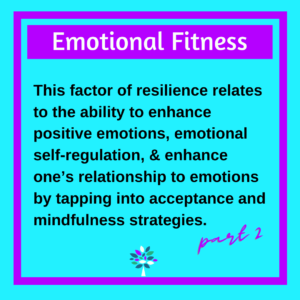Emotional Fitness – pt 2

Resilience is the capacity to adapt successfully in the presence of risk and adversity. This is the second post exploring the aspect of emotional fitness.
Emotional fitness is the ability to enhance positive emotions, self-regulate emotions, and enhance one’s relationship to emotions by tapping into acceptance and mindfulness strategies.
When emotionally aroused or triggered start practicing ‘opposite actions’ to the unhealthy solutions you normally engage in. So instead of avoiding situations and reminders of things you don’t want to think about, you can reach out to a friend to actually talk about the situation. Instead of attacking someone when you are angry you can learn to take time out and talk about it later. Instead of putting yourself or others down, learn to let go of judgement.
Give yourself permission to feel those negative feelings. Emotions are normal and healthy and we must learn to be able to sit with them. There are emotional tolerance exercises that you can learn to build that tolerance. There are mindfulness exercises for learning to simply notice how you are feeling. Negative emotions are signals that something is wrong, and you can learn to take this information in to inform what you do. Learn mindfulness activities in which you learn to simply observe your emotions or thoughts, without the need to judge, act or to see them as fact.
Avoid avoidance. Fear is a natural emotion and we naturally to try to avoid things we fear, or we try to control them through obsessive worrying and planning. But avoidance only strengthens the fear. Instead learn to practice visualizing what you want to happen in the feared situation. Do some reality testing around your fears to get a better sense of how realistic they are. Think about a fear you have overcome in the past and how you did so.
If you have had trauma, learning to share your story can help in a myriad of ways. You can implement the practice of journaling or blogging to work through past experiences. Increase your awareness of what is triggering and plan for what you need when triggered to strong emotions. Learn grounding skills. Get into therapy to deal with it if needed.
Learn to become aware of your self-talk and how it impacts your emotions. Then start changing how you walk to yourself to improve how you feel.
Get creative as a means to express and process your emotions. It does not matter if you are good, what matters is the doing and enjoying. Writing, painting, making music, sculpting, collaging, whatever it is that allows you to express yourself emotionally.
Much of the above information is taken from Dr. Donald Meichenbaum’s book Roadmap to Resilience: A guide for military, trauma victims and their families.










